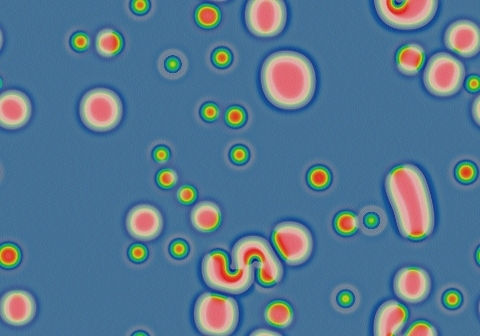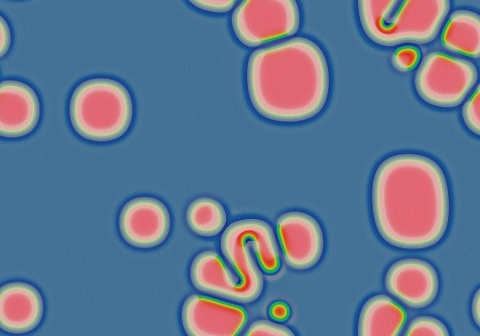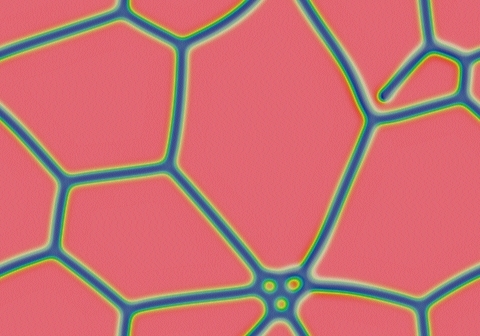Gray-Scott Model at F 0.1020, k 0.0550
These images and movie demonstrate the behavior of the Gray-Scott reaction-diffusion system with σ=Du/Dv=2 and parameters F=0.1020, k=0.0550.
On a red background, blue spots form solitons or worms that grow to fill the space.
On a blue background (as seen here), red spots below a critical size shrink and vanish, while spots above that minimum size grow into a network of lines with the occasional worm. Cells coalesce like soap bubbles and the pattern evolves towards a network of hexagons, except for the occasional defect caused by a cell containing a worm. As seen here (1:05-1:32) cells containing worms can get squeezed out. Sometimes a few negatons can survive longer by clumping (compare top-right at 1:15-1:28 to bottom-center at 1:40-2:10). This pattern evolves for about another 5,000,000 tu.
(old video: fm9TqketQqw was encoded poorly.)
Categories: Munafo ρ; Wolfram 2-a (glossary of terms)
 increase F increase F
 | |||
  |


|
15 frames/sec.; each fr. is 736 iter. steps = 368 tu; 3601 fr. total (1,325,168 tu) |  increase k 
|

|


| ||
 decrease F decrease F
 |
In these images:
- Color indicates level of u, ranging from purple (lowest u values) through blue, aqua, green, yellow and pink/red (highest u values)
- Areas where u is increasing are lightened to a light pastel tone; where u is decreasing the color is vivid.
- In areas where u is changing by less than ±3×10-6 per tu, an intermediate pastel color is seen. This includes areas that are in steady state or equilibrium.
''tu'' is the dimensionless unit of time, and ''lu'' the dimensionless unit of length, implicit in the equations that define the reaction-diffusion model. The grids for these simulations use Δx=1/143 lu and Δt=1/2 tu; the system is 3.2 lu wide. The simulation meets itself at the edges (periodic boundary condition); all images tile seamlessly if used as wallpaper.
Go back to Gray-Scott pattern index
This page was written in the "embarrassingly readable" markup language RHTF, and was last updated on 2015 Nov 07.
 s.27
s.27